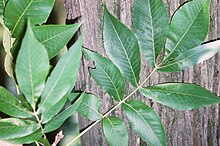This article includes a list of general references, but it lacks sufficient corresponding inline citations. (August 2022) |

| Shellbark hickory | |
|---|---|

| |
| Leaves and bark | |
| Scientific classification | |
| Kingdom: | Plantae |
| Clade: | Tracheophytes |
| Clade: | Angiosperms |
| Clade: | Eudicots |
| Clade: | Rosids |
| Order: | Fagales |
| Family: | Juglandaceae |
| Genus: | Carya |
| Section: | Carya sect. Carya |
| Species: | C. laciniosa
|
| Binomial name | |
| Carya laciniosa | |

| |
| Natural range | |
Carya laciniosa, the shellbark hickory, in the Juglandaceae or walnut family is also called kingnut, big, bottom, thick, or western shellbark, attesting to some of its characteristics. It is a slow-growing, long-lived tree, hard to transplant because of its long taproot, and subject to insect damage. The nuts, largest of all hickory nuts, are sweet and edible. Wildlife and people harvest most of them; those remaining produce seedling trees readily. The wood is hard, heavy, strong, and very flexible, making it a favored wood for tool handles. A specimen tree has been reported in Missouri with 117 cm (46 in) diameter at breast height, 36.9 m (121 ft 1 in) tall, and a spread of 22.6 m (74 ft 2 in).
- ^ Stritch, L. (2018). "Carya laciniosa". IUCN Red List of Threatened Species. 2018: e.T62019631A62019633. doi:10.2305/IUCN.UK.2018-1.RLTS.T62019631A62019633.en. Retrieved 19 November 2021.
